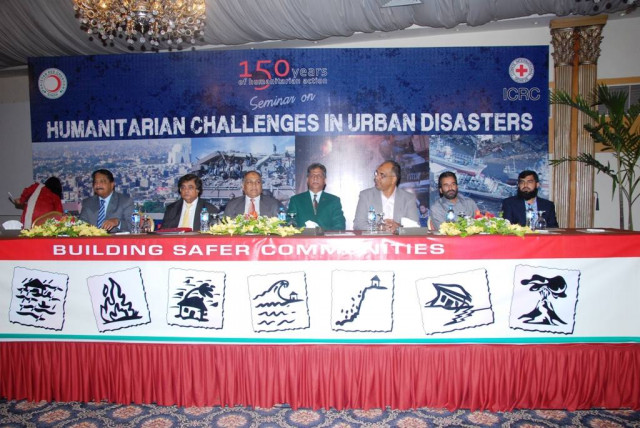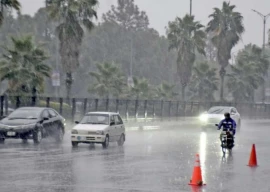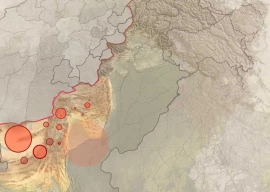
The city boasts a population of at least 20 million, placed in one of the world's most seismically active regions — on top of three tectonic fault lines.
With a population density of 4,000 per kilometre, research shows that Karachi is the world's third-most congested city. It is a coastal city and, considering its location, it is fortunate that no recent major natural disasters have been recorded.
But if they do, and a cyclone or earthquake does hit Karachi, is the city prepared? More importantly, are its people prepared? Are they trained enough to know what must be done?
To address these questions, a seminar on 'Humanitarian Response on Urban Disasters' was organised by the Pakistan Red Crescent Society Sindh, with the support of the International Red Cross Committee.
As experts shared their knowledge, those who understood the importance of the subject listened intently, while others in the audience continued to chat in hushed tones instead of listening to what may, one day, prove to be potentially life-saving information.
The seminar focused on three key themes. The first was response, which included recovery and relief procedures in case of a disaster. The second was resilience, which was about working towards the community's adaptation in case of any potential hazard. The final was transformation, which discussed how to make the community less vulnerable to natural disasters.
What would become of Gulshan-e-Iqbal?
Professor M Ahmed of the NED University of Engineering and Technology presented the findings of his research paper, titled 'Seismic Risk Assessment', and the findings are alarming, to say the least.
According to the academic, his study, which focused on Gulshan-e-Iqbal as a sample of Karachi, is 85 per cent accurate. The research involved studying in great detail, the buildings of the area — the architecture and the building materials used and hence, their vulnerability in the face of an earthquake. According to Ahmed, an earthquake of average strength would result in 87 per cent of the area's buildings being partly damaged or completely destroyed.
Risks and solutions
"Karachi has more people living within a 30-km radius of its nuclear plant than any other city in the world - around eight million," said the former Sindh IG, Niaz Siddiqui, who talked about 'Reducing Social Vulnerabilities to Urban Disasters'. "We are not prepared and we must raise awareness."
However, he added that there is a difference between early warnings and creating panic. "Warnings empower, while panic does the exact opposite," he said. In this context, he emphasised that the media must exercise restraint in the wake of such situations.
Siddiqui then discussed global instances where disasters relating to radioactivity have caused havoc. "Luckily Pakistan does not have such a history [of a radioactive disaster]," he said.
The director of the Karachi Regional Metrological Centre, Sardar Sarfaraz, while presenting his findings and experiences on 'Threats of Coastal Disaster to Urban Settings', reminded the audience of previous disasters and discussed the risks Karachi faces due to its location. "April to June and October to November are the most vulnerable months in terms of cyclone development," he said.
A representative of the Pakistan Disaster Management Authority explained that the government's task becomes tougher in the face of disasters because of Pakistan's uneven population density and the diverse geographical characteristics of various regions. "Poverty feeds vulnerabilities," he said, echoing what most speakers had shared.
Published in The Express Tribune, April 6th, 2014.

















COMMENTS
Comments are moderated and generally will be posted if they are on-topic and not abusive.
For more information, please see our Comments FAQ